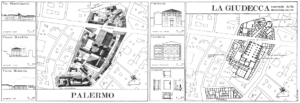European Day of Jewish Culture – The Ancient and Unique Jewish History of Sicily
“I first took an interest in the history of the Jewish Sicily towards the end of the 1980s. I had the chance to read Obadia Da Bertinoro’s writings on the synagogue of Palermo. Thus I began to study this subject”. Architect David Cassuto was the vice mayor of Jerusalem between 1993 and 1998, in which period he committed himself to the city’s urban and cultural development in particular. While talking to Pagine Ebraiche, Mr. Cassuto has been recalling the detailed studies he carried out on the Sicilian Jewish community, starting from the very writings that made him wonder what was, and what is, left.
“The synagogue of Palermo has a unique value. In its courtyard, grapevines climb up stone pillars. I had never seen such grapevines before, of which one – I measured it – was five span thick. Several stone steps lead down to the entrance of the courtyard, situated in front of the synagogue. This one is enclosed by an exedra, a foyer for people who do not want to enter the synagogue. In the above-mentioned courtyard, there is a beautiful well. The door of the square-shaped synagogue, 40 cubit long and 40 cubit wide, is on the fourth side”. This is how Obadia, an important Italian rabbi well-known for his commentary on the Mishnah, the fundamental text of the Oral Torah, describes his stay in the Sicilian capital in a 1488 letter to his father, living in Città di Castello. He spent three months in the city during his long journey from Bertinoro, Northern Italy – from which he took his last name – to Jerusalem, where he became a cornerstone of the local community. Few years later, the Jews would be thrown out of Spain and all its territories – including Southern Italy – and the life of that large community, which had thrived there for centuries, would come to an end.
From his words also began Mr. Cassuto’s physical and intellectual journey throughout Sicily, often accompanied by Margherita De Simone, the then president of the Department of Architecture of the University of Palermo, Professor Rosalia La Franca and Nicolò Bucaria, the author of many scientific writings on the subject. “Some years ago came the opportunity of visiting Palermo and I seized it enthusiastically. In those years, I was curious about the history of the city and its Jewish community in particular”, he wrote in the first lines of one of his essays. “I was astonished when I arrived in Palermo in June 1992 and found out that extensive research had already been conducted on over sixty giudecche [the Sicilian Jewish communities]”.
One of the key points of his research was finding the exact location of the synagogue that Bertinoro had described. To do so, Mr. Cassuto used not only the Master’s letter, but also the bill of sale of the synagogue, of the complex including a mikveh (a ritual bath) and a shelter for the ill, poor and travelers and even of the whole district, which was written when the Jews had to rapidly give away their properties after the Spanish sovereigns’ edict. The author was Abraam De Orefice. The bill mentions more than 40 houses and small shops, a slaughterhouse, a courtyard “with pergolas, Bizzaria and lemon trees, pillars, wells and the small fountain”.
The most tangible proof of the synagogue’s location is the name of the square that stands in the area of the old Jewish district: “Meschita”, the ancient name of the synagogue. Among other things, in Piazza Meschita is located today the Historical Archive of Palermo (as well as the Congregazione Madonna del Sabato, which a few months ago gave its oratory to the local Jewish community on loan for use).
However, Architect Cassuto studied the old maps of the city as well and visited the various places to be sure of his findings. “I was allowed to enter the basements of the Archive. I talked to the Authority for the sewerage system to know if they had found anything while digging in the area. They replied that they had found, indeed, some stone benches. Then I understood where the courtyard and the synagogue were. I was thrilled”, he said. The story behind the word “Meschita” is peculiar. It is the Latinization of the Arabic word for “mosque”, which suggests that maybe the building was originally a Muslim temple, or that the local dialect kept an Arabic word to call places of worship other than the churches.
Mr. Cassuto’s studies on the Jewish Sicily also focused on many other subjects inside and outside Palermo, which led to further remarkable discoveries, such as the ritual bath in Syracuse. “Sicily was the main landfall for travellers coming to Italy from East”, Mr. Cassuto added. “I think we would find much more by excavating and looking in the archives. It’s a job that needs to be done”.
*Translation made by Federica Alabiso, student at the Advanced School for Interpreters and Translators of Trieste University, intern at the newspaper office of the Union of the Italian Jewish Communities.

